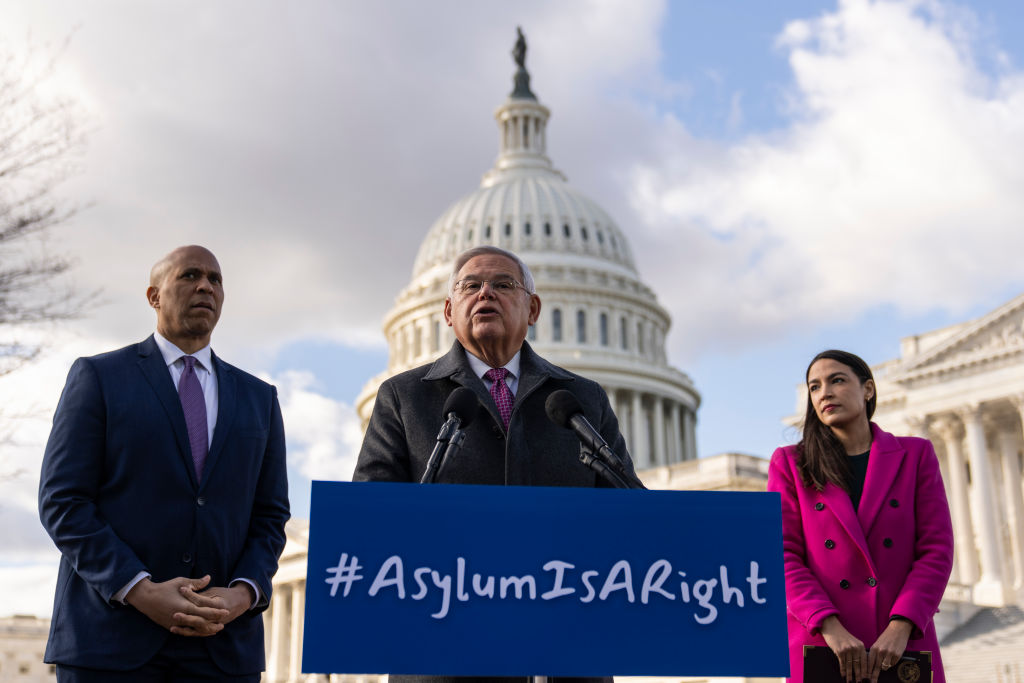Title 42 has allowed the Biden administration to take draconian measures against immigrants at the border. Since when is immigration control a more effective selling point than compassion?

The COVID-19 pandemic is still with us, although most people have resumed a semblance of pre-pandemic life. Emergency powers invoked during the early days of the global crisis have waned, travel and trade have reopened, and despite outbreaks and mutations, COVID-19 does not hold sway as it did during those early frightening days of death and despair—except at the U.S. border with Mexico, where, under the notorious Title 42 policy, the pandemic is routinely invoked to justify expelling immigrants seeking asylum without any semblance of review or due process.
Late last year, it appeared that the Title 42 policy would finally be terminated after a federal court found it unlawful—but the Supreme Court ruled in early January that the policy must remain in effect during the ongoing legal challenge brought by state governments.
To make matters worse, the Biden administration has recently announced a series of border enforcement reforms that depend upon the Title 42 policy. Today’s border policies remain rooted in the pandemic in a way that has surprised and angered immigration advocates and public health experts.
In March 2020, the Trump administration blocked people from seeking asylum at the border by twisting the CDC’s authority under Title 42 of the U.S. Code to suspend entry of persons arriving from countries where a contagious disease was prevalent. Public health experts, and many others, criticized both the order and the ensuing Title 42 expulsion policy as unnecessary, overreaching and cruel. Nonetheless, the policy quickly took hold, even as it was challenged in federal court, resulting in over 2.4 million expulsions to date.
Even as we learned more about COVID-19 and how to prevent and treat it, and even as vaccinations became widely available, Title 42 restrictions did not go away. The Biden administration moved slowly, continuing to rely on the existence of the CDC order to justify further expulsions, even as it relaxed some restrictions for certain groups or nationalities. When the government signaled that the CDC would rescind the original order and that Title 42 policies would be terminated, many Republican governors and some legislators from both parties continued to insist that Title 42 was necessary to manage border crossings, bringing lawsuits and proposing unsuccessful legislation to force the policies to continue.
Title 42 had become a workaround for immigration law, particularly the law that permits anyone within the U.S. to apply for asylum. Since Title 42 policies involved closing ports of entry to asylum applicants and expelling people without any formal review, the government and other leaders could rationalize that they were technically blocked from entering the United States and therefore weren’t entitled to access the asylum process.
But the writing is on the wall. Despite the Supreme Court’s procedural decision to allow Title 42 policies to remain in effect, most legal experts believe that the Title 42 immigration policies cannot last—in large part because the underlying order justifying Title 42 no longer exists. It’s an illusion that can no longer be justified.

But this has not stopped the Biden administration from expanding its use in the meantime. In an effort to reduce unauthorized migration and create more orderly legal pathways, the administration has created new programs that will permit some Venezuelans, Haitians, Nicaraguans and Cubans to receive temporary parole into the U.S. People who don’t apply for these programs who arrive at the border without authorization will be expelled under Title 42. The administration will also expand its use of expedited removal, funneling even more people into a fast-track removal process.
And when Title 42 ends? The Biden administration plans to dust off Trump era rules that would have barred access to asylum for anyone who fails to take advantage of asylum or other protections in countries along their route to the U.S. Since this remains impossible for most migrants, especially those who began their long journey before the new policy was announced, they will effectively have no way to access the United States.
The Biden administration insists that the new rules are not the same as those proposed under Trump, but no one has seen the proposals yet. More to the point, they can be revised or watered down or tempered with exceptions, but if they are just designed to keep people with legitimate protection needs out of the country, they are legally and morally wrong.
Biden is not Trump. The Trump administration was hell-bent on destroying the refugee system and the right to asylum long before the pandemic struck, while the Biden administration has restored and expanded refugee admissions, restored some pre-Trump asylum policies and embarked on major parole programs to welcome Afghans, Ukrainians and others in need of protection. The Biden administration’s approach to legal immigration and immigrant integration is far more welcoming and inclusive than was his predecessor’s.
But when it comes to Title 42, the Biden administration has been loath to give back the power it inherited to attempt to control the border. In a world where a fractured Congress is unable to pass the kind of sweeping reforms needed to provide legal pathways for job-seekers and those wanting to reunite with family, there are limited tools for discouraging unauthorized migration. This makes the use of Title 42 authority attractive because it reduces the immediate demand on the system, allowing the government to demonstrate an ability to quickly remove people.
This is mostly an illusion, as there is a high rate of repeat attempts to cross the border following a Title 42 expulsion, and many individuals may wait days or weeks until they are actually turned away, while others still find a way to make a case for the higher standard of withholding of removal—a form of protection without the benefits of asylum. Ultimately, nobody wins and thousands of people expelled under Title 42 face death, sexual exploitation, violence and misery, but the sound bite remains intact. And the sound bite seems to be governing immigration policy.
There are a lot of lessons to be learned here.
Once bad ideas circulate, they don’t go away. Once a government agency has authority to do something, it is reluctant to let it go. Perhaps most important, once the public has accepted a policy—or more precisely, once there appears to be little political cost for implementing a policy—the incentive to continue apace is often too tempting, even for fundamentally well-meaning leaders.
Good words and intentions aside, Title 42 has allowed the Biden administration to take draconian measures against immigrants at the border, and the public has, so far, not really seemed to care. This success has emboldened those within the administration who think that immigration is a poison pill to urge taking even more pages from the Trump playbook, believing that immigration control is a more effective selling point than compassion.
Take Action
It doesn’t have to be this way. We have to keep pressing the point that we can’t use pandemic solutions to solve long-term, systemic immigration problems. We have to make it clear that Trump-era immigration policies will not be resurrected. And we have to continually draw the connection between America’s success and the manner in which we respond to the desperate, the poor and the persecuted who ask for our help. We have to join the more than 80 members of Congress who have called on President Biden to reverse course and keep his promises to protect those seeking asylum.
Biden is not Trump, but that doesn’t mean that his policies have not been influenced by the government he inherited from Trump or by decades of failed approaches to managing migration at our southern border. The Trump legacy continues every time good people allow the vestiges of anti-democratic impulses to flourish in the shadows.
Continuing Title 42, or proposing more bans on asylum, keep the spirit of anti-immigrant sentiment alive.
Up next:





